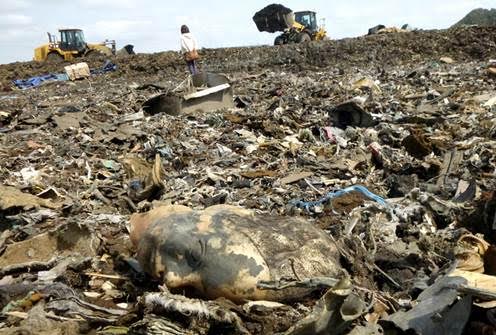KUP ODPADKOV NA OTOKU TESHIMA
Teshima is an island in the Inland Sea of Japan, between the islands of Naoshima and Shodoshima, and is part of Kagawa prefecture.
North western sector of the island is considered as one of the worst cases of illegal dumping of industrial waste in Japan. Waste was transported by ships, which sailed past the islands and left behind about 600,000 tons of all sorts of things, from industrial debris to various acids, waste oil … It accumulate on the island since World War II. and still occupy almost 80,000 km2 area of 14.5 km2 large island.
All of these toxic substances were quickly destroying aquatic life and natural culture along the coast, and thus jeopardize the livelihood of local fishermen and farmers, who were surviving by fishing and fish farms, which were forced to cease due to contamination. In addition, garbage endanger the aesthetics of the landscape and contaminate the soil and groundwater. An investigation in 1995 revealed dangerous levels of lead and other substances.
Project against companies for the disposal of industrial waste started an activist Shozo Aki in 1975. He decided to perform the mass combat against business with industrial waste.
Thus, in 2000, residents agreed with the government of Kagawa prefecture on the plan that they remove any waste from the island. Initially built impervious wall on the north coast to prevent the contaminated water from landfills from flowing into the sea.
Detoxification and recycling process of illegally dumped waste and contaminated soil were started in 2003. The hearing was originally scheduled for completion in 2012, but was extended for further period of 5 years, since the waste increased to 920,000 tons from 600,000 originally estimated tons. So far they have managed to remove only a third.
The waste is loaded on a ship and sent to Naoshima, where it is re-melted, detoxified and transformed into slag, which is re-used as aggregate in concrete.
Tourists, who visit the island say they are surprised by the layer’s thickness. Waste, that they disposed all the time, created an area composed of large layers of garbage. Thus, the waste can be detected only one after another layer, which extend the excavation.
Currently, the story about the island disappears with time. The population fell sharply due to emigration and age. Even fewer people know about the event. The islanders are still trying to revive the economy.
Ritsuko Yamugi, 60 year housewife and her husband started growing strawberries in greenhouses, which are sold at stores in Tokyo. In 2010 islanders opened an art museum, which today attracts tourists. In accordance with this project they invited the local population to participate in rebuilding uncultivated fields, which are located around the Museum of Art and turn them into paddy fields. Damaged ecosystems are also restoring. It is said that most visitors without prior knowledge does not notice that the island was once severely destroyed.
Location
Japan, Teshima island, Kagawa prefecture
Environmental impact
- Land degradation (e.g. drought, soil contamination, erosion and desertification)
- Biodiversity loss – Ecosystem destruction
- Depletion of natural resources (fossil and mineral, forest, water, etc)
- Waste, waste disposal, and toxicants
- Alteration of landscape aesthetics and built heritage
Ethical/ legal issues
- Life and personal security
- Health and well-being
- A clean and prosperous environment and a safe and pleasant habitat
- Equality before the law and protection by the law (including marginalized and discriminated groups because of colour, race, gender, disability, descent, economic status, age, etc.)
- Opportunities to work and leisure
- Indigenous land, culture and rituals
- Personal and social development, economic progress and innovation
Other: Loss of livelihood, loss of traditional knowledge/practices/cultures, loss of landscape/sense of place
Information sources & materials
Online books and newspaper, magazine, encyclopedia, or blog articles
- https://ejatlas.org/conflict/teshima-island-waste-dispute
- http://www.japantimes.co.jp/news/2007/06/07/national/islands-environment-recovering-from-illegal-waste-residents-try-to-follow-suit/#.WRYBR8Lr3ct
- http://www.nytimes.com/2003/07/02/world/japanese-winning-cleanup-battles.html
- http://www.bard.edu/cep/blog/?p=7549
- http://www.japantimes.co.jp/news/2000/05/27/national/teshima-island-waste-dispute-nears-end/#.WRYBtMLr3ct
- https://www.iru-miru.com/article_detail.php?id=12132
- https://books.google.es/books?id=Bg1JCAAAQBAJ&pg=PT53&lpg=PT53&dq=teshima+island+waste&source=bl&ots=kJqyohJSZV&sig=hUcTEp7IU53ermCMTKgdb9AYhxI&hl=en&sa=X&ved=0ahUKEwjyvbeY09XQAhXBlxoKHSazDa84ChDoAQg1MAY#v=onepage&q=teshima%20island%20waste&f=false
- http://benesse-artsite.jp/en/art/teshima-artmuseum.html
Links to images, online videos, documentary movies, etc
Contributor(s)
Kira Arčon
Rebeka Jerina



Home › Forums › Pile of waste on Teshima island